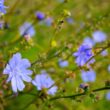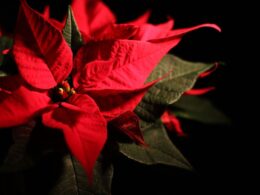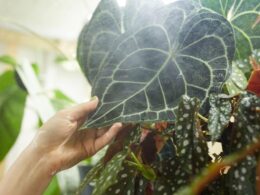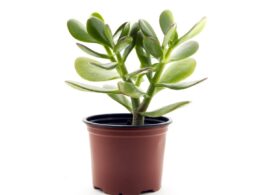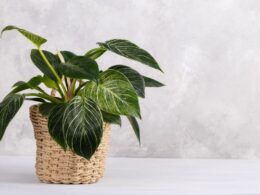What Is Alocasia ‘Polly?’ The Characteristics and Origin of Alocasia
Alocasia ‘Polly’ is a cultivar of Alocasia, a genus of plants native to subtropical and tropical Asia. It’s also known as the African mask plant or elephant ear. There are more cultivars of the hybrid A. × amazonica, but ‘Polly’ is the most popular. Our tips for alocasia plant care will refer to this variety, but they work for others as well.
This plant is easily recognizable by its large, glossy green leaves with light green veins. The leaves are vaguely heart-shaped and can grow up to 20 inches long and 10 inches wide. The stems are thin and upright. Whether you’re an aroid collector or just a plant lover, alocasia will add the perfect amount of drama to your indoor jungle!
Alocasia Plant Care – Soil Type and Fertilizer
Alocasia plants aren’t picky when it comes to soil type. A loose, well-draining potting mix recommended for aroids will do the trick. You can also use a peat-based potting mix with added perlite or vermiculite for extra drainage.
While they’re not heavy feeders, these plants benefit from a monthly feeding of an all-purpose fertilizer during the growing season. Be sure to dilute the fertilizer to half the recommended strength.
Alocasia Plant Care – Watering
If you planted your alocasia in well-drained soil, you shouldn’t have trouble keeping it lightly moist but not wet. Never let it dry out completely, but don’t water it so often that the leaves start to yellow and drop.
During the winter months, alocasia plant care is a little different. You can allow the top few inches of soil to dry out before watering again. These plants go dormant during the winter and won’t need as much water.
How Much Light Alocasia Plants Need
Alocasia thrives in bright, indirect light. They can tolerate some direct sunlight, but it’s best to keep them out of the hottest afternoon sun. Keep in mind that the plant will grow in the direction of the light, so rotate it every few days to keep it looking symmetrical.
Ideal Temperatures and Humidity for Alocasia Plants
Since they’re tropical plants, alocasia plant care involves providing warmth and humidity. African mask plants prefer warm temperatures between 65 and 80 degrees Fahrenheit. They’ll tolerate a bit of temperature fluctuation, but won’t do well in drafts.
These plants also enjoy high humidity, so they’re the perfect addition to a bathroom (as long as it has windows) or kitchen. If you can’t provide enough natural humidity, mist your alocasia plant regularly or set the pot on a pebble tray.
Pruning Alocasia Plants
As alocasia plants grow, you may need to prune them to keep them looking their best. Use sharp, sterile pruning shears to remove any yellow or dying leaves. You can also cut back leggy stems during dormancy to encourage new growth.
How to Propagate African Mask Plants
Alocasia plant care is easy, but propagation is more difficult than it is for most plants. These plants are typically propagated by division – stem cuttings aren’t recommended because alocasia grows from a central corm.
To divide alocasia, wait until the plant has outgrown its pot and then carefully remove it from the pot. Shake off any excess soil and then use a sharp, clean knife to divide the tuber or rhizome in two or more sections. They should have their own root systems already, so be careful not to damage the roots.
Replant each section in its own pot filled with well-drained potting mix. Water the plants well and then place them in a warm, humid spot with bright, indirect light. Keep an eye on the soil and water as needed to keep it moist but not wet. It may take several weeks or months for new growth to appear.
Repotting African Mask Plants
Alocasia isn’t a fast-growing indoor plant, but it will eventually outgrow its pot and roots will start coming out of the drainage holes. When that happens, you’ll need to repot it in a slightly larger pot. The best time to do this is in the spring before new growth appears.
- Use the same potting soil you used when you first potted the plant.
- Gently remove the alocasia from its current pot and then shake off any excess soil.
- Carefully place the plant in the new pot, not disturbing the roots.
- Fill in any empty spaces with potting mix and then water well.
Common Diseases of African Mask Plants
While alocasia plant care isn’t hard, there are a few diseases you may want to look out for. These include root rot, powdery mildew, leaf spot, and xanthomonas infection. As for pests, alocasias can become infested with spider mites, mealybugs and scale.
- Crown, stem and root rot is usually caused by too much water or poorly drained soil. The first sign of root rot is wilting leaves, followed by yellowing and then browning.
- Powdery mildew is a fungal disease that appears as white or gray powder on the leaves. Left untreated, it can cause the leaves to yellow and eventually drop off.
- Leaf spot is another fungal disease that causes brown or black spots on the foliage. The spots may be circular or irregular in shape.
- Xanthomonas infection is a bacterial disease that causes yellow or brown spots on the leaves, which may eventually drop off.
If you notice any of these problems, take action immediately. Remove any affected leaves and then carefully check the roots. If they’re rotted, you’ll need to remove the affected roots and replant your alocasia in fresh potting mix. If the problem is powdery mildew, leaf spot, or xanthomonas infection, you may be able to treat it with a fungicide or bactericide.
Now you know everything about alocasia plant care. With a little effort, you can keep your alocasia healthy and looking its best!
Do you have any more tips? Share them in the comments below!







